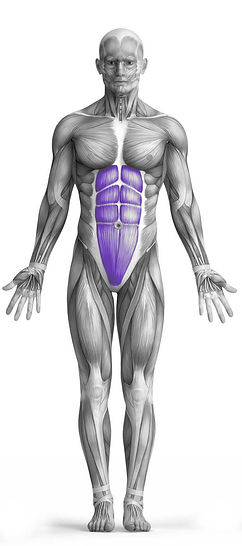Scissor Kick 101 Video Tutorial
0

Exercise Synopsis
Target Muscle Group
Abs
Secondary Targets
Execution
Compound
Force Type
Core
Required Equipment
Bodyweight
Fitness Level
Intermediate
Variations
Alternatives
None
Timer
Hour
Minute
Second
Stopwatch
00:00:00:00
Overview
The Scissor Kick is a core-strengthening exercise that targets the abdominal muscles as its primary focus, with secondary engagement of the obliques. This bodyweight exercise involves lying on one's back, lifting the legs slightly off the ground, and alternating crossing them over each other in a scissoring motion. The exercise requires no equipment, making it accessible for anyone, anywhere. By engaging the core muscles, particularly the abdominals, the Scissor Kick helps improve core stability, enhances abdominal strength, and contributes to overall functional fitness.
How to Perform
Scissor kicks serve as a dynamic exercise aimed at strengthening the abdominal muscles and enhancing core stability. The movement entails a controlled crisscross motion, with legs moving horizontally in and out.
Executed while lying face-up, legs are extended straight and lifted approximately 45 degrees off the floor, engaging both the upper and lower abdominal muscles.
The exercise targets the abs as the primary muscle group, with additional emphasis placed on the obliques, aiding in overall core development and torso strength.
Unlike static exercises, such as planks, scissor kicks involve continuous movement, providing a dynamic challenge to the core and promoting coordination and balance.
Scissor kicks require no additional equipment, making them accessible for individuals of varying fitness levels and can be performed virtually anywhere, offering versatility in workout routines.
Incorporating scissor kicks into a comprehensive fitness regimen can contribute to improved posture, enhanced athletic performance, and reduced risk of injury by strengthening the core muscles essential for stability and movement control.
Tips
Begin by lying flat on your back with your arms at your sides and palms facing down.
Engage your core muscles by pressing your lower back into the ground.
Lift your legs off the floor, keeping them straight and together, until they are at a 45-degree angle with the ground.
Lower one leg towards the floor while keeping the other leg lifted, maintaining tension in your abs.
Avoid arching your back or allowing your lower back to lift off the ground.
Slowly alternate legs in a scissoring motion, crossing one leg over the other, while maintaining control throughout the movement.
Focus on breathing steadily throughout the exercise, exhaling as you switch legs and inhaling as you hold the position.
Keep your neck and shoulders relaxed, avoiding tension buildup in these areas.
Aim for a smooth and controlled movement pattern, emphasizing quality over speed.
Gradually increase the difficulty by lowering your legs closer to the ground without compromising form, as you build strength and endurance in your core muscles.
How Not to Perform
Avoid overarching your lower back: Maintain a slight posterior pelvic tilt to keep your lower back pressed against the ground throughout the exercise, preventing strain on the lumbar spine.
Do not rush the movement: Focus on controlled and deliberate movements, avoiding swinging or jerking motions that can reduce the effectiveness of the exercise and increase the risk of injury.
Prevent excessive neck tension: Keep your neck relaxed and avoid pulling on it with your hands, allowing your core muscles to bear the workload without unnecessary strain on the neck and shoulders.
Avoid holding your breath: Maintain steady breathing throughout the exercise, inhaling as you hold the position and exhaling as you switch legs, to optimize oxygen flow to your muscles and maintain endurance.
Do not allow your legs to drop too low: Maintain the 45-degree angle of your legs with the ground to keep tension on the abdominal muscles, preventing the exercise from becoming less effective or causing strain on the lower back.
Avoid using momentum: Engage your core muscles fully to lift and lower your legs, avoiding reliance on momentum or swinging motions that can detract from the targeted muscle engagement and increase the risk of injury.
Prevent excessive tension in the shoulders: Keep your shoulders relaxed and avoid lifting them off the ground, focusing the energy and effort on the abdominal muscles rather than unnecessary tension in the upper body.
Do not neglect proper form: Ensure your legs remain straight and together throughout the exercise, maintaining alignment from hips to toes, to maximize muscle activation and prevent strain on the knees and hips.
Avoid compensating with the secondary muscle groups: While the obliques provide support, focus on engaging the primary target muscle group, the abs, to prevent energy wastage and ensure maximum benefit from the exercise.
Do not sacrifice quality for quantity: Prioritize proper form and technique over the number of repetitions, performing each repetition with precision and control to optimize muscle recruitment and minimize the risk of injury.
Variations
Variations of fitness exercises refer to different ways of performing a specific exercise or movement to target various muscle groups, intensities, or goals. These variations aim to challenge the body differently, prevent plateaus, and cater to individuals with varying fitness levels.
Alternatives
Alternative exercises in fitness refer to different movements or activities that target similar muscle groups or serve the same training purpose as the primary exercise. These alternative exercises can be used as substitutes when the original exercise is unavailable or challenging to perform due to various reasons such as equipment limitations, injuries, or personal preferences.



